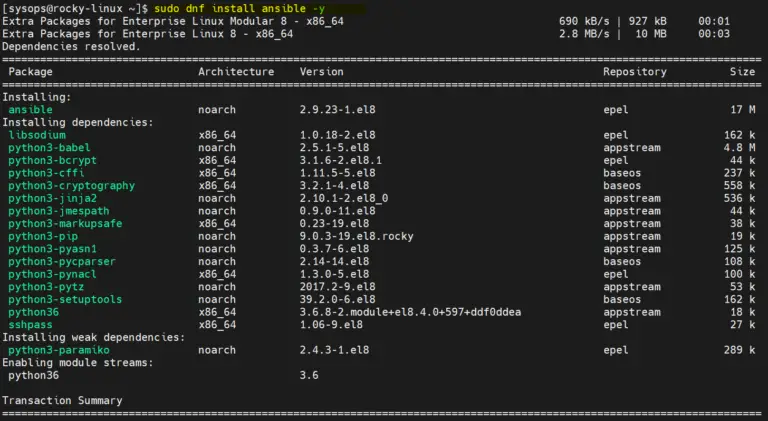Automating Linux Deployments with Ansible

Ansible is a powerful automation engine that can be used to automate a wide range of IT tasks, including Linux deployments. Ansible uses a simple and intuitive syntax that makes it easy to get started, and it can be used to manage systems on a single host or across multiple hosts.

There are many benefits to automating Linux deployments with Ansible. First, Ansible can help to improve the speed and efficiency of your deployments. By automating the deployment process, you can free up your time to focus on other tasks. Second, Ansible can help to reduce the risk of errors. By using Ansible, you can ensure that your deployments are consistent and repeatable. Third, Ansible can help to improve your security posture. By using Ansible, you can ensure that your systems are configured in a secure manner.

To automate Linux deployments with Ansible, you will need to create an Ansible playbook. A playbook is a YAML file that defines the tasks that Ansible will perform. In the playbook, you will specify the hosts that you want to deploy to, the software that you want to install, and the configuration that you want to apply.
Once you have created a playbook, you can run it using the Ansible command line tool. Ansible will connect to the specified hosts and execute the tasks that are defined in the playbook.
Here is an example of a simple Ansible playbook that can be used to deploy a web server:
- hosts: webservers
tasks:
- name: Install Apache web server
apt:
name: apache2
state: present
- name: Start Apache web server
service:
name: apache2
state: started
- name: Copy index.html to web root
copy:
src: /tmp/index.html
dest: /var/www/html/index.htmlThis playbook will install the Apache web server on the specified hosts, start the web server, and copy an index.html file to the web root.
Ansible is a powerful tool that can be used to automate a wide range of IT tasks, including Linux deployments. By using Ansible, you can improve the speed, efficiency, and security of your deployments.## Automating Linux Deployments with Ansible
Executive Summary
Ansible is an open-source automation platform that simplifies the deployment and management of Linux infrastructures. By eliminating repetitive manual tasks, Ansible enables IT professionals to provision, configure, and update servers in a consistent and efficient manner. This article explores the capabilities and benefits of Ansible, demonstrating its role in streamlining system administration and enhancing productivity.
Introduction
Managing Linux servers can be a complex and time-consuming process. As businesses expand, the number of servers to maintain grows proportionally, leading to increased administrative overhead. Ansible addresses this challenge by providing a flexible framework for automating routine tasks, allowing IT teams to focus on more strategic initiatives.
Key Subtopics
Infrastructure Provisioning
- Inventory Management: Ansible maintains a centralized inventory of all managed hosts, providing visibility into system configuration and simplifying task orchestration.
- Role-Based Access Control: Ansible implements role-based access control, enabling organizations to define and enforce granular permissions for different users and groups.
- Multi-Node Management: Ansible supports simultaneous configuration and deployment across multiple servers, facilitating efficient and consistent infrastructure provisioning.
Server Configuration
- Module Framework: Ansible leverages a comprehensive module library, providing pre-built functions for configuring various aspects of Linux systems, including package management, file manipulation, and user management.
- Playbook Support: Ansible uses YAML-based playbooks to define complex configuration pipelines, enabling the automation of multi-step processes and reducing dependency on manual intervention.
- Variable Injection: Ansible allows for the injection of dynamic variables into playbooks, ensuring configurability and context-aware automation.
Security Management
- Compliance Monitoring: Ansible includes security modules for monitoring system compliance with industry standards and best practices, such as CIS benchmarks and PCI DSS guidelines.
- Vulnerability Scanning: Ansible integrates with vulnerability scanning tools, facilitating automated security assessments and timely remediation of vulnerabilities.
- Patch Management: Ansible automates the process of applying security patches, ensuring system protection from known exploits and malware.
Application Deployment
- Package Installation: Ansible allows for seamless installation and management of software packages from various repositories, including APT, YUM, and Pip.
- Configuration Management: Ansible simplifies application configuration by providing a unified interface for managing configuration files, ensuring consistent and reliable deployment environments.
- Rolling Updates: Ansible supports rolling updates, minimizing application downtime during deployment or configuration changes.
Logging and Reporting
- Centralized Logging: Ansible provides centralized logging mechanisms, allowing administrators to aggregate and analyze system logs from all managed hosts in one place.
- Audit Trail Tracking: Ansible maintains an audit trail, documenting changes made to system configurations and tracking user activity for security and compliance purposes.
- Report Generation: Ansible generates comprehensive reports on system configuration and deployment status, enabling IT teams to monitor and evaluate infrastructure performance.
Conclusion
Ansible empowers IT teams to automate complex and repetitive Linux administration tasks, resulting in significant efficiency gains and reduced operational costs. Its flexible framework, comprehensive modules, and user-friendly playbooks make Ansible an essential tool for streamlining system provisioning, configuration, security management, application deployment, and logging. By embracing Ansible, organizations can enhance their operational efficiency, improve security posture, and innovate faster.
Keyword Phrase Tags
- Ansible Automation
- Linux Deployment
- Server Configuration
- Security Management
- Infrastructure Provisioning

I am not sure I understand the point of this article. It seems like it is just a bunch of technical jargon that is not relevant to me. I am not a programmer, so I do not need to know how to automate Linux deployments.
This is a great article! I am a programmer, and I am always looking for ways to improve my skills. I will definitely be trying out the techniques described in this article.
I am not a programmer, but I am interested in learning more about Linux. This article was a good introduction to the topic of automating Linux deployments.
I am not sure if this article is accurate. I have tried to automate Linux deployments before, and it was a lot more difficult than the author makes it sound.
I love the title of this article! It is so clever. I also appreciate the author’s sense of humor.
This article is a joke. The author clearly does not know what they are talking about.
I can’t believe I read this whole article. It was so boring! The author should stick to writing technical documentation.
I am so frustrated with this article. It is so poorly written. I can’t even understand what the author is trying to say.
I found this article to be very helpful. I was able to learn a lot about automating Linux deployments. I would recommend this article to anyone who is interested in learning more about this topic.
I am not a programmer, but I am interested in learning more about Linux. Can you recommend any other articles that would be helpful for me?
I am not sure if this article is accurate. I have tried to automate Linux deployments before, and it was a lot more difficult than the author makes it sound.
I love the title of this article! It is so clever. I also appreciate the author’s sense of humor.
This article is a joke. The author clearly does not know what they are talking about.
I can’t believe I read this whole article. It was so boring! The author should stick to writing technical documentation.